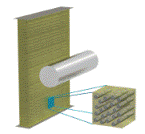Mechanical & Materials Engineering, Department of
Date of this Version
Spring 3-27-2013
Citation
Ganpule, S., "Mechanics of blast loading on post-mortem human and surrogate heads in the study of Traumatic Brain Injury (TBI) using experimental and computational approaches," Ph.D. dissertation, 2013.
Abstract
Blast induced neurotrauma (BINT) has been designated as the “signature injury” to warfighters in the recent military conflicts. The occurrence of traumatic brain injury (TBI) in blasts is controversial in the medical and scientific communities because the manifesting symptoms occur without visible injuries. Whether the primary blast waves alone can cause mechanical insult that is comparable to existing traumatic brain injury thresholds is still an open question, and this work is aimed to address this issue.
In the first part of this dissertation, mechanics of primary blast loading on Realistic Explosive Dummy (RED) head with and without helmets is studied using experiments and a validated numerical model. It is shown that geometry of the head and helmet, their configurations and orientations with respect to the direction of the blast govern the flow dynamics around the head; these factors in turn determine the surface pressures. The blast wave can focus under the helmet if there is a gap between the head and the helmet leading to an increase in surface pressures beneath the focused regions.
In the second part of this dissertation, the response of post-mortem human specimen (PMHS) heads is studied. Three PMHS heads are subjected to primary blast of varying peak incident intensities or overpressures (70 kPa, 140 kPa and 200 kPa). When the incident blast intensity is increased, there is a statistically significant increase in the peak intracranial pressure (ICP) and total impulse (p<0.05). Further, for blast overpressures of 140 kPa and 200 kPa, ICP values exceed brain injury thresholds available in the literature based on blunt impacts. From the parametric studies on the validated human head model, it is seen that the wave propagation through skin-skull-brain parenchyma plays prominent role in governing ICP-time histories. The effect of helmets on PMHS head is also analyzed. The results suggest that based only on ICP blast mitigation offered by the current helmets may be marginal, if at all.
Advisers: Namas Chandra and Linxia Gu
Included in
Applied Mechanics Commons, Biomechanical Engineering Commons, Engineering Mechanics Commons


Comments
A DISSERTATION Presented to the Faculty of The Graduate College at the University of Nebraska In Partial Fulfillment of Requirements For the Degree of Doctor of Philosophy, Major: Engineering, Under the Supervision of Professors Namas Chandra and Linxia Gu. Lincoln, Nebraska: March, 2013
Copyright (c) 2013 Shailesh Govind Ganpule